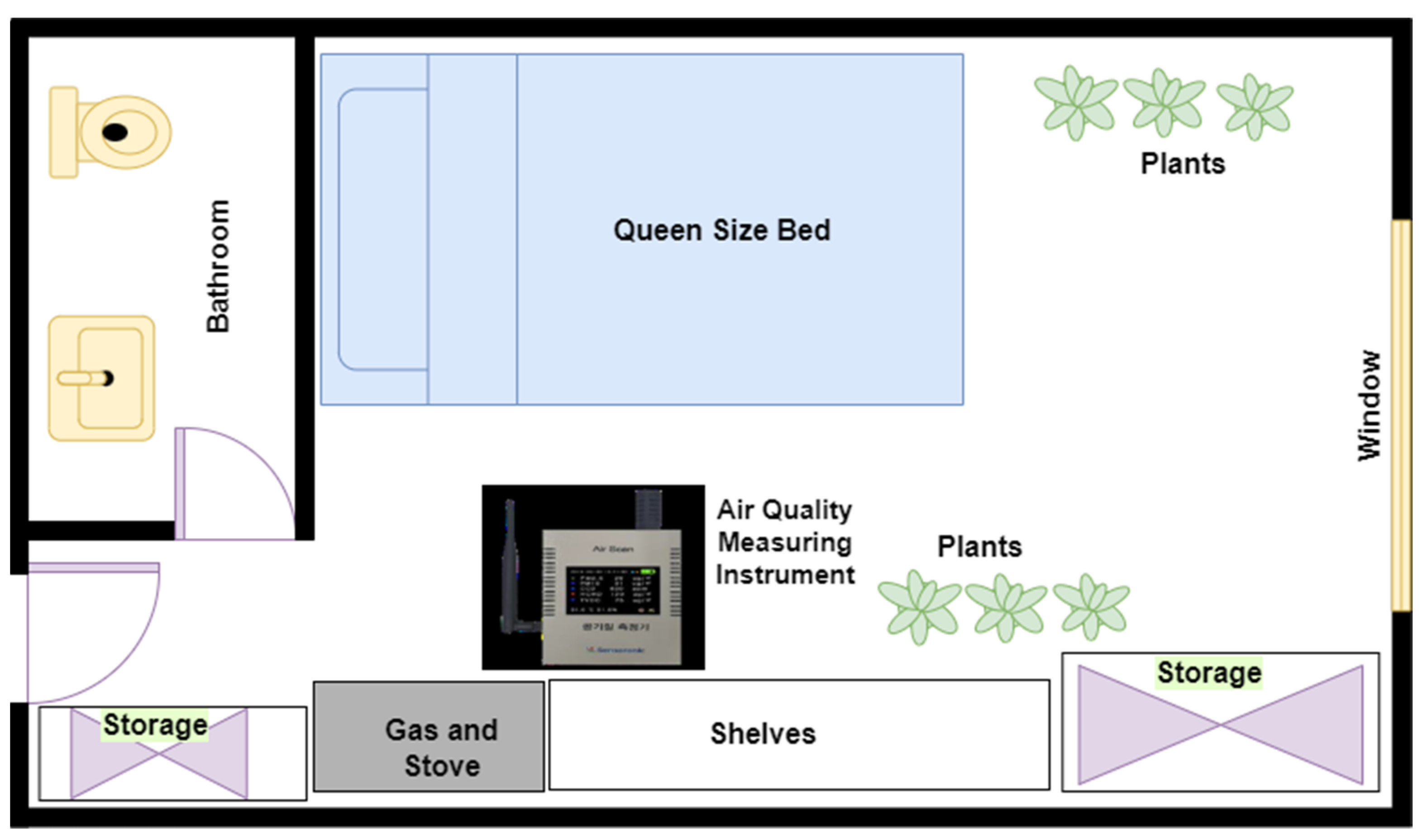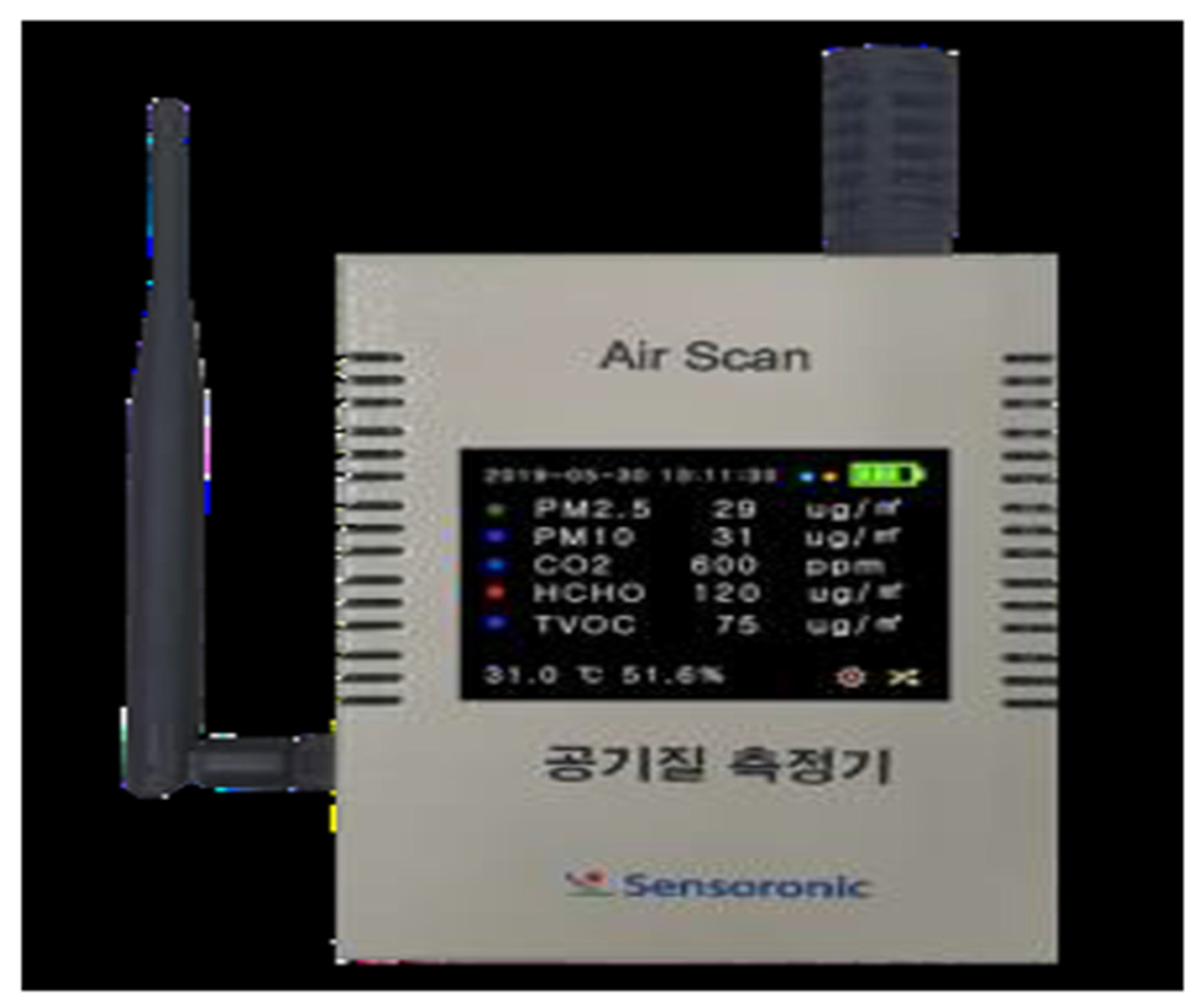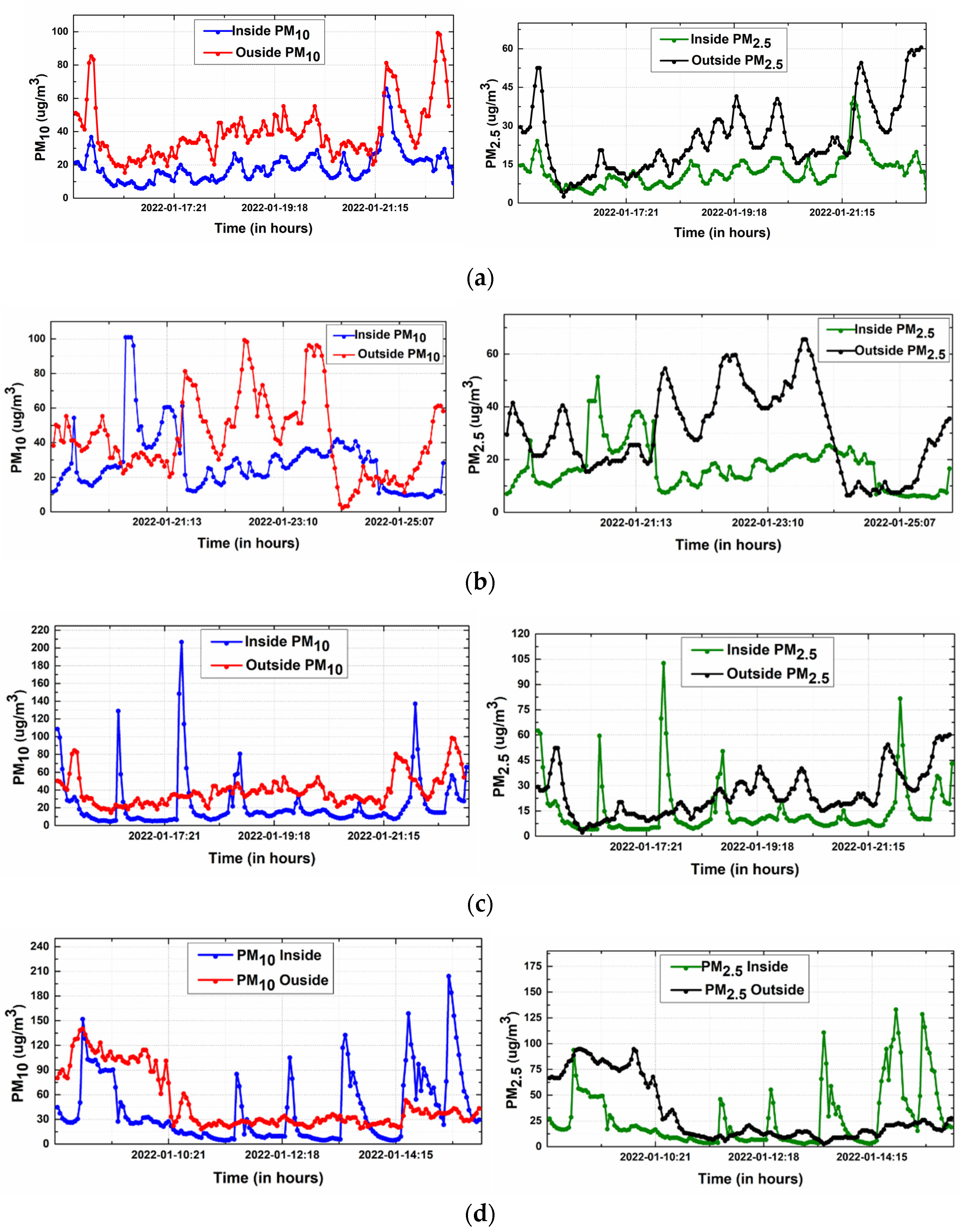Evaluation of the Effectiveness of Common Indoor Plants in Improving the Indoor Air Quality of Studio Apartments
Abstract
1. Introduction
2. Materials and Methods
2.1. Study Location
2.2. Plant Preparation
2.3. Indoor Air Pollutants Measurements
2.4. Data Analysis
2.5. Calculation of Air Exchange Rate (AER), Deposition and Emission Rate
3. Results
3.1. Indoor and Outdoor PM2.5 and PM10 Concentration
3.2. Indoor TVOC, HCHO, and CO2 Concentrations
3.2.1. Total Volatile Organic Compound (TVOC) Concentrations
3.2.2. Formaldehyde (HCHO) Concentration
3.2.3. Carbon Dioxide (CO2) Concentration
4. Discussion
5. Conclusions
Supplementary Materials
Author Contributions
Funding
Institutional Review Board Statement
Informed Consent Statement
Data Availability Statement
Conflicts of Interest
References
- Brook, R.D.; Rajagopalan, S.; Pope, C.A.; Brook, J.R.; Bhatnagar, A.; Diez-Roux, A.V.; Holguin, F.; Hong, Y.; Luepker, R.V.; Mittleman, M.A.; et al. Particulate Matter Air Pollution and Cardiovascular Disease: An Update to the Scientific Statement from the American Heart Association. Circulation 2010, 121, 2331–2378. [Google Scholar] [CrossRef] [PubMed]
- Crouse, D.L.; Peters, P.A.; Hystad, P.; Brook, J.R.; van Donkelaar, A.; Martin, R.V.; Villeneuve, P.J.; Jerrett, M.; Goldberg, M.S.; Arden Pope, C.; et al. Ambient PM2.5, O3, and NO2 Exposures and Associations with Mortality over 16 Years of Follow-up in the Canadian Census Health and Environment Cohort (CanCHEC). Environ. Health Perspect. 2015, 123, 1180–1186. [Google Scholar] [CrossRef] [PubMed]
- Shuai, J.; Kim, S.; Ryu, H.; Park, J.; Lee, C.K.; Kim, G.B.; Ultra, V.U.; Yang, W. Health Risk Assessment of Volatile Organic Compounds Exposure near Daegu Dyeing Industrial Complex in South Korea. BMC Public Health 2018, 18, 528. [Google Scholar] [CrossRef] [PubMed]
- Zhang, X.; Li, X.; Wang, Z.; Deng, G.; Wang, Z. Exposure Level and Influential Factors of HCHO, BTX and TVOC from the Interior Redecoration of Residences. Build. Environ. 2020, 168, 106494. [Google Scholar] [CrossRef]
- Jahanzaib, B.; Irshad, D.; Park, M.Z. Development of Driving Cycle for Passenger Cars and Estimation of Vehicular Exhaust Emission Factors. J. Environ. Pollut. Control 2022, 5, 1–11. [Google Scholar] [CrossRef]
- Hoek, G.; Krishnan, R.M.; Beelen, R.; Peters, A.; Ostro, B.; Brunekreef, B.; Kaufman, J.D. Long-Term Air Pollution Exposure and Cardio-Respiratory Mortality: A Review. Environ. Health A Glob. Access Sci. Source 2013, 12, 43. [Google Scholar] [CrossRef] [PubMed]
- Brasche, S.; Bischof, W. Daily Time Spent Indoors in German Homes—Baseline Data for the Assessment of Indoor Exposure of German Occupants. Int. J. Hyg. Environ. Health 2005, 208, 247–253. [Google Scholar] [CrossRef]
- Schweizer, C.; Edwards, R.D.; Bayer-Oglesby, L.; Gauderman, W.J.; Ilacqua, V.; Juhani Jantunen, M.; Lai, H.K.; Nieuwenhuijsen, M.; Künzli, N. Indoor Time-Microenvironment-Activity Patterns in Seven Regions of Europe. J. Expo. Sci. Environ. Epidemiol. 2007, 17, 170–181. [Google Scholar] [CrossRef] [PubMed]
- Chen, C.; Zhao, B. Review of Relationship between Indoor and Outdoor Particles: I/O Ratio, Infiltration Factor and Penetration Factor. Atmos. Environ. 2011, 45, 275–288. [Google Scholar] [CrossRef]
- Vardoulakis, S.; Giagloglou, E.; Steinle, S.; Davis, A.; Sleeuwenhoek, A.; Galea, K.S.; Dixon, K.; Crawford, J.O. Indoor Exposure to Selected Air Pollutants in the Home Environment: A Systematic Review. Int. J. Environ. Res. Public Health 2020, 17, 8972. [Google Scholar] [CrossRef]
- Maisey, S.J.; Saunders, S.M.; West, N.; Franklin, P.J. An Extended Baseline Examination of Indoor VOCs in a City of Low Ambient Pollution: Perth, Western Australia. Atmos. Environ. 2013, 81, 546–553. [Google Scholar] [CrossRef]
- Geiss, O.; Giannopoulos, G.; Tirendi, S.; Barrero-Moreno, J.; Larsen, B.R.; Kotzias, D. The AIRMEX Study—VOC Measurements in Public Buildings and Schools/Kindergartens in Eleven European Cities: Statistical Analysis of the Data. Atmos. Environ. 2011, 45, 3676–3684. [Google Scholar] [CrossRef]
- Bruce, N.; Perez-Padilla, R.; Albalak, R. The Health Effects of Indoor Air Pollution Exposure in Developing Countries. Geneva World Health Organ. Rep. 2002, 11, 1–40. [Google Scholar]
- Lui, K.H.; Bandowe, B.A.M.; Ho, S.S.H.; Chuang, H.C.; Cao, J.J.; Chuang, K.J.; Lee, S.C.; Hu, D.; Ho, K.F. Characterization of Chemical Components and Bioreactivity of Fine Particulate Matter (PM2.5) during Incense Burning. Environ. Pollut. 2016, 213, 524–532. [Google Scholar] [CrossRef] [PubMed]
- Pan, A.; Clark, M.L.; Ang, L.W.; Yu, M.C.; Yuan, J.M.; Koh, W.P. Incense Use and Cardiovascular Mortality among Chinese in Singapore: The Singapore Chinese Health Study. Environ. Health Perspect. 2015, 122, 1279–1284. [Google Scholar] [CrossRef] [PubMed]
- Daghigh, R. Assessing the Thermal Comfort and Ventilation in Malaysia and the Surrounding Regions. Renew. Sustain. Energy Rev. 2015, 48, 681–691. [Google Scholar] [CrossRef]
- Torpy, F.R.; Irga, P.J.; Burchett, M.D. Profiling Indoor Plants for the Amelioration of High CO2 Concentrations. Urban For. Urban Green. 2014, 13, 227–233. [Google Scholar] [CrossRef]
- Zuraimi, M.S.; Vuotari, M.; Nilsson, G.; Magee, R.; Kemery, B.; Alliston, C. Impact of Dust Loading on Long Term Portable Air Cleaner Performance. Build. Environ. 2017, 112, 261–269. [Google Scholar] [CrossRef]
- Wolverton, B.C.; Mcdonald, R.C.; Watkins, E.A. Foliage Plants for Removing Indoor Air Pollutants from Energy-Efficient Homes. Econ. Bot. 1984, 38, 224–228. [Google Scholar] [CrossRef]
- Wolverton, B.; Wolverton, J. Plants and Soil Microorganisms: Removal of Formaldehyde, Xylene, and Ammonia from the Indoor Environment. J. Miss. Acad. Sci. 1993, 38, 11–15. [Google Scholar]
- Liu, Y.J.; Mu, Y.J.; Zhu, Y.G.; Ding, H.; Crystal Arens, N. Which Ornamental Plant Species Effectively Remove Benzene from Indoor Air? Atmos. Environ. 2007, 41, 650–654. [Google Scholar] [CrossRef]
- Kvesitadze, E.; Sadunishvili, T.; Kvesitadze, G. Mechanisms of Organic Contaminants Uptake and Degradation in Plants. Int. J. Biol. Biomed. Eng. 2009, 3, 458–468. [Google Scholar]
- Moya, T.A.; van den Dobbelsteen, A.; Ottelé, M.; Bluyssen, P.M. A Review of Green Systems within the Indoor Environment. Indoor Built Environ. 2019, 28, 298–309. [Google Scholar] [CrossRef]
- Darlington, A.B.; Dat, J.F.; Dixon, M.A. The Biofiltration of Indoor Air: Air Flux and Temperature Influences the Removal of Toluene, Ethylbenzene, and Xylene. Environ. Sci. Technol. 2001, 35, 240–246. [Google Scholar] [CrossRef]
- Feng, H.; Hewage, K. Lifecycle Assessment of Living Walls: Air Purification and Energy Performance. J. Clean. Prod. 2014, 69, 91–99. [Google Scholar] [CrossRef]
- Wang, Z.; Pei, J.; Zhang, J.S. Experimental Investigation of the Formaldehyde Removal Mechanisms in a Dynamic Botanical Filtration System for Indoor Air Purification. J. Hazard. Mater. 2014, 280, 235–243. [Google Scholar] [CrossRef]
- Torpy, F.; Zavattaro, M.; Irga, P. Green Wall Technology for the Phytoremediation of Indoor Air: A System for the Reduction of High CO2 Concentrations. Air Qual. Atmos. Health 2017, 10, 575–585. [Google Scholar] [CrossRef]
- Soreanu, G.; Dixon, M.; Darlington, A. Botanical Biofiltration of Indoor Gaseous Pollutants—A Mini-Review. Chem. Eng. J. 2013, 229, 585–594. [Google Scholar] [CrossRef]
- Satish, U.; Mendell, M.J.; Shekhar, K.; Hotchi, T.; Sullivan, D. Concentrations on Human Decision-Making Performance. Environ. Health Perspect. 2012, 120, 1671–1678. [Google Scholar] [CrossRef]
- Kwon, S.B.; Jeong, W.; Park, D.; Kim, K.T.; Cho, K.H. A Multivariate Study for Characterizing Particulate Matter (PM10, PM2.5, and PM1) in Seoul Metropolitan Subway Stations, Korea. J. Hazard. Mater. 2015, 297, 295–303. [Google Scholar] [CrossRef]
- Rim, D.; Gall, E.T.; Kim, J.B.; Bae, G.N. Particulate Matter in Urban Nursery Schools: A Case Study of Seoul, Korea during Winter Months. Build. Environ. 2017, 119, 1–10. [Google Scholar] [CrossRef]
- Claude-Alain, R.; Foradini, F. Simple and Cheap Air Change Rate Measurement Using CO2 Concentration Decays. Int. J. Vent. 2002, 1, 39–44. [Google Scholar] [CrossRef]
- He, L.Y.; Hu, M.; Huang, X.F.; Yu, B.D.; Zhang, Y.H.; Liu, D.Q. Measurement of Emissions of Fine Particulate Organic Matter from Chinese Cooking. Atmos. Environ. 2004, 38, 6557–6564. [Google Scholar] [CrossRef]
- He, C.; Morawska, L.; Gilbert, D. Particle Deposition Rates in Residential Houses. Atmos. Environ. 2005, 39, 3891–3899. [Google Scholar] [CrossRef]
- Guo, L.; Lewis, J.O.; McLaughlin, J.P. Emissions from Irish Domestic Fireplaces and Their Impact on Indoor Air Quality When Used as Supplementary Heating Source. Glob. Nest J. 2008, 10, 209–216. [Google Scholar] [CrossRef][Green Version]
- Vicente, E.D.; Evtyugina, M.; Vicente, A.M.; Calvo, A.I.; Oduber, F.; Blanco-Alegre, C.; Castro, A.; Fraile, R.; Nunes, T.; Lucarelli, F.; et al. Impact of Ironing on Indoor Particle Levels and Composition. Build. Environ. 2021, 192, 107636. [Google Scholar] [CrossRef]
- Aquilina, N.J.; Camilleri, S.F. Impact of Daily Household Activities on Indoor PM2.5 and Black Carbon Concentrations in Malta. Build. Environ. 2022, 207, 108422. [Google Scholar] [CrossRef]
- Amouei Torkmahalleh, M.; Zhigulina, Z.; Madiyarova, T.; Turganova, K.; Adotey, E.K.; Sabanov, S. Exposure to Fine, Ultrafine Particles and Black Carbon in Two Preschools in Nur-Sultan City of Kazakhstan. Indoor Air 2021, 31, 1178–1186. [Google Scholar] [CrossRef]
- Gawrońska, H.; Bakera, B. Phytoremediation of Particulate Matter from Indoor Air by Chlorophytum Comosum L. Plants. Air Qual. Atmos. Health 2015, 8, 265–272. [Google Scholar] [CrossRef]
- Mo, L.; Ma, Z.; Xu, Y.; Sun, F.; Lun, X.; Liu, X.; Chen, J.; Yu, X. Assessing the Capacity of Plant Species to Accumulate Particulate Matter in Beijing, China. PLoS ONE 2015, 10, e0140664. [Google Scholar] [CrossRef]
- Zhao, S.; Zhao, Y.; Liang, H.; Su, Y. Formaldehyde Removal in the Air by Six Plant Systems with or without Rhizosphere Microorganisms. Int. J. Phytoremediation 2019, 21, 1296–1304. [Google Scholar] [CrossRef] [PubMed]
- Bhargava, B.; Malhotra, S.; Chandel, A.; Rakwal, A.; Kashwap, R.R.; Kumar, S. Mitigation of Indoor Air Pollutants Using Areca Palm Potted Plants in Real-Life Settings. Environ. Sci. Pollut. Res. 2021, 28, 8898–8906. [Google Scholar] [CrossRef] [PubMed]
- Lee, H.; Jun, Z.; Zahra, Z. Phytoremediation: The Sustainable Strategy for Improving Indoor and Outdoor Air Quality. Environments 2021, 8, 118. [Google Scholar] [CrossRef]
- Permana, B.H.; Thiravetyan, P.; Treesubsuntorn, C. Effect of Airflow Pattern and Distance on Removal of Particulate Matters and Volatile Organic Compounds from Cigarette Smoke Using Sansevieria Trifasciata Botanical Biofilter. Chemosphere 2022, 295, 133919. [Google Scholar] [CrossRef] [PubMed]
- Kim, K.J.; Lim, Y.W.; Kim, H.H.; Il Jeong, M.; Lee, D.W.; Song, J.S.; Kim, H.D.; Yoo, E.H.; Jeong, S.J.; Han, S.W.; et al. Variation in Formaldehyde Removal Efficiency among Indoor Plant Species. Hortscience 2010, 45, 1489–1495. [Google Scholar] [CrossRef]
- Treesubsuntorn, C.; Thiravetyan, P. Botanical Biofilter for Indoor Toluene Removal and Reduction of Carbon Dioxide Emission under Low Light Intensity by Using Mixed C3 and CAM Plants. J. Clean. Prod. 2018, 194, 94–100. [Google Scholar] [CrossRef]
- Siswanto, D.; Permana, B.H.; Treesubsuntorn, C.; Thiravetyan, P. Sansevieria Trifasciata and Chlorophytum Comosum Botanical Biofilter for Cigarette Smoke Phytoremediation in a Pilot-Scale Experiment—Evaluation of Multi-Pollutant Removal Efficiency and CO2 Emission. Air Qual. Atmos. Health 2020, 13, 109–117. [Google Scholar] [CrossRef]
- Khaksar, G.; Treesubsuntorn, C.; Thiravetyan, P. Effect of Endophytic Bacillus Cereus ERBP Inoculation into Non-Native Host: Potentials and Challenges for Airborne Formaldehyde Removal. Plant Physiol. Biochem. 2016, 107, 326–336. [Google Scholar] [CrossRef]
- Setsungnern, A.; Treesubsuntorn, C.; Thiravetyan, P. The Influence of Different Light Quality and Benzene on Gene Expression and Benzene Degradation of Chlorophytum Comosum. Plant Physiol. Biochem. 2017, 120, 95–102. [Google Scholar] [CrossRef]
- Sandhu, A.; Halverson, L.J.; Beattie, G.A. Bacterial Degradation of Airborne Phenol in the Phyllosphere. Environ. Microbiol. 2007, 9, 383–392. [Google Scholar] [CrossRef]
- Torpy, F.; Clements, N.; Pollinger, M.; Dengel, A.; Mulvihill, I.; He, C.; Irga, P. Testing the Single-Pass VOC Removal Efficiency of an Active Green Wall Using Methyl Ethyl Ketone (MEK). Air Qual. Atmos. Health 2018, 11, 163–170. [Google Scholar] [CrossRef] [PubMed]
- Ghate, S. Phytoremediation of Formaldehyde in Indoor Environment With Common House Plants and Pseudomonas Chlororaphis. J. Earth Environ. Sci. Res. 2021, 3, 1–7. [Google Scholar] [CrossRef]
- Han, Y.; Lee, J.; Haiping, G.; Kim, K.H.; Wanxi, P.; Bhardwaj, N.; Oh, J.M.; Brown, R.J.C. Plant-Based Remediation of Air Pollution: A Review. J. Environ. Manag. 2022, 301, 113860. [Google Scholar] [CrossRef] [PubMed]
- Jung, C.; Awad, J. Improving the Iaq for Learning Efficiency with Indoor Plants in University Classrooms in Ajman, United Arab Emirates. Buildings 2021, 11, 289. [Google Scholar] [CrossRef]



| Experimental Sites | Area, Door, Window No. of Occupants | Ventilation | Indoor Plant |
|---|---|---|---|
| Apartment I (APT I) | 10-Pyeong (~33 m2), 1, 1, 1 | With Ventilation | With Indoor Plants. |
| Apartment II (APT II) | 10-Pyeong (~33 m2), 1, 1, 1 | Without Ventilation | With Indoor Plants (only CAM plants). |
| Apartment III (APT III) | 10-Pyeong (~33 m2), 1, 1, 1 | With Ventilation | Without Indoor Plants. |
| Apartment IV (APT IV) | 10-Pyeong (~33 m2), 1, 1, 1 | Without Ventilation | Without Indoor Plants |
| Plant | Family | Common Name | Plant Type |
|---|---|---|---|
| Sansevieria kirkii | Asparagaceae | Snake Plant | CAM carbon fixation. |
| Sansevieria trifasciata | Asparagaceae | Snake Plant | CAM carbon fixation. |
| Monstera deliciosa | Araceae | Swiss Cheese Plant | C3 carbon fixation. |
| Zamiifolia | Araceae | ZZ-plant | C3 carbon fixation |
| Portulacaria afra | Didiereaceae | Jade plant | C3 or CAM carbon fixation |
| Indoor Pollutant | Apartment | Condition | Mean ± SE | Reduction Rate (%) |
|---|---|---|---|---|
| PM10 | Apartment I (APT I) | Ventilation ✔ & Indoor plant (C3 + CAM) ✔ | 19.4 ± 0.74 | 67.01% |
| Apartment II (APT II) | Ventilation ✘ & Indoor plant (CAM) ✔ | 21.82 ± 0.21 | 62.89% | |
| Apartment III (APT III) | Ventilation ✔ & Indoor plant ✘ | 29.02 ± 0.94 | 50.65% | |
| Apartment IV (APT IV) | Ventilation ✘ & Indoor plant ✘ | 58.81 ± 1.66 | Control | |
| PM2.5 | Apartment I (APT I) | Ventilation ✔ & Indoor plant (C3 + CAM) ✔ | 12.64 ± 0.32 | 64.61% |
| Apartment II (APT II) | Ventilation ✘ & Indoor plant (CAM) ✔ | 17.11 ± 0.13 | 52.09% | |
| Apartment III (APT III) | Ventilation ✔ & Indoor plant ✘ | 15.94 ± 0.5 | 56.63% | |
| Apartment IV (APT IV) | Ventilation ✘ & Indoor plant ✘ | 35.72 ± 0.96 | Control | |
| TVOC | Apartment I (APT I) | Ventilation ✔ & Indoor plant (C3 + CAM) ✔ | 56.35±6.59 | 92.95% |
| Apartment II (APT II) | Ventilation ✘ & Indoor plant (CAM) ✔ | 190.93 ± 7.63 | 76.14% | |
| Apartment III (APT III) | Ventilation ✔ & Indoor plant ✘ | 84.42 ± 3.03 | 89.41% | |
| Apartment IV (APT IV) | Ventilation ✘ & Indoor plant ✘ | 800.41 ± 14.73 | Control | |
| HCHO | Apartment I (APT I) | Ventilation ✔ & Indoor plant (C3 + CAM) ✔ | 6.023 ± 0.255 | 74.89% |
| Apartment II (APT II) | Ventilation ✘ & Indoor plant (CAM) ✔ | 5.98 ± 0.06 | 75.07% | |
| Apartment III (APT III) | Ventilation ✔ & Indoor plant ✘ | 34.67 ± 0.35 | −30% | |
| Apartment IV (APT IV) | Ventilation ✘ & Indoor plant ✘ | 23.99 ± 0.32 | Control | |
| CO2 | Apartment I (APT I) | Ventilation ✔ & Indoor plant (C3 + CAM) ✔ | 615.5 ± 2.73 | 76.47% |
| Apartment II (APT II) | Ventilation ✘ & Indoor plant (CAM) ✔ | 1154.52 ± 10.83 | 55.87% | |
| Apartment III (APT III) | Ventilation ✔ & Indoor plant ✘ | 1278.42 ± 9.27 | 51.13% | |
| Apartment IV (APT IV) | Ventilation ✘ & Indoor plant ✘ | 2616.36 ± 25.81 | Control |
Publisher’s Note: MDPI stays neutral with regard to jurisdictional claims in published maps and institutional affiliations. |
© 2022 by the authors. Licensee MDPI, Basel, Switzerland. This article is an open access article distributed under the terms and conditions of the Creative Commons Attribution (CC BY) license (https://creativecommons.org/licenses/by/4.0/).
Share and Cite
Sharma, S.; Bakht, A.; Jahanzaib, M.; Lee, H.; Park, D. Evaluation of the Effectiveness of Common Indoor Plants in Improving the Indoor Air Quality of Studio Apartments. Atmosphere 2022, 13, 1863. https://doi.org/10.3390/atmos13111863
Sharma S, Bakht A, Jahanzaib M, Lee H, Park D. Evaluation of the Effectiveness of Common Indoor Plants in Improving the Indoor Air Quality of Studio Apartments. Atmosphere. 2022; 13(11):1863. https://doi.org/10.3390/atmos13111863
Chicago/Turabian StyleSharma, Shambhavi, Ahtesham Bakht, Muhammad Jahanzaib, Hyunsoo Lee, and Duckshin Park. 2022. "Evaluation of the Effectiveness of Common Indoor Plants in Improving the Indoor Air Quality of Studio Apartments" Atmosphere 13, no. 11: 1863. https://doi.org/10.3390/atmos13111863
APA StyleSharma, S., Bakht, A., Jahanzaib, M., Lee, H., & Park, D. (2022). Evaluation of the Effectiveness of Common Indoor Plants in Improving the Indoor Air Quality of Studio Apartments. Atmosphere, 13(11), 1863. https://doi.org/10.3390/atmos13111863







